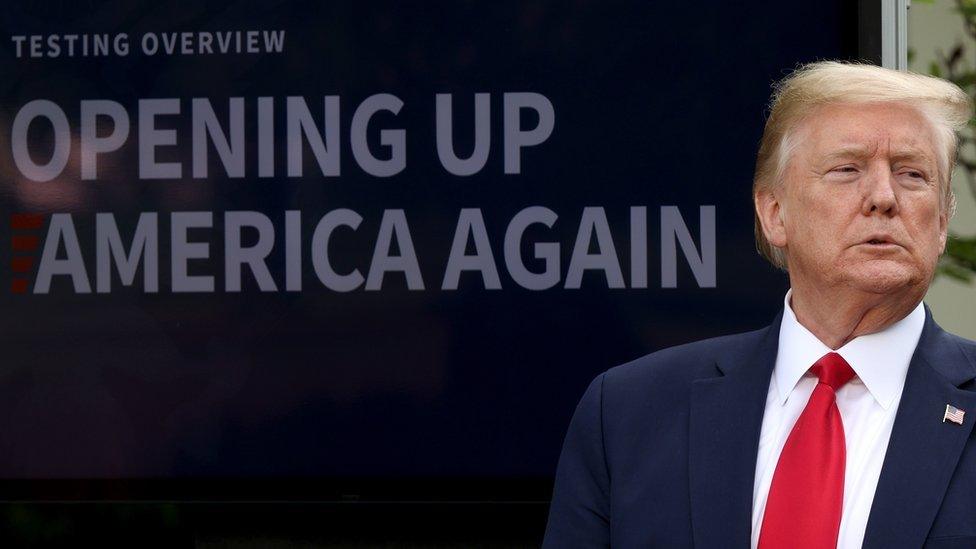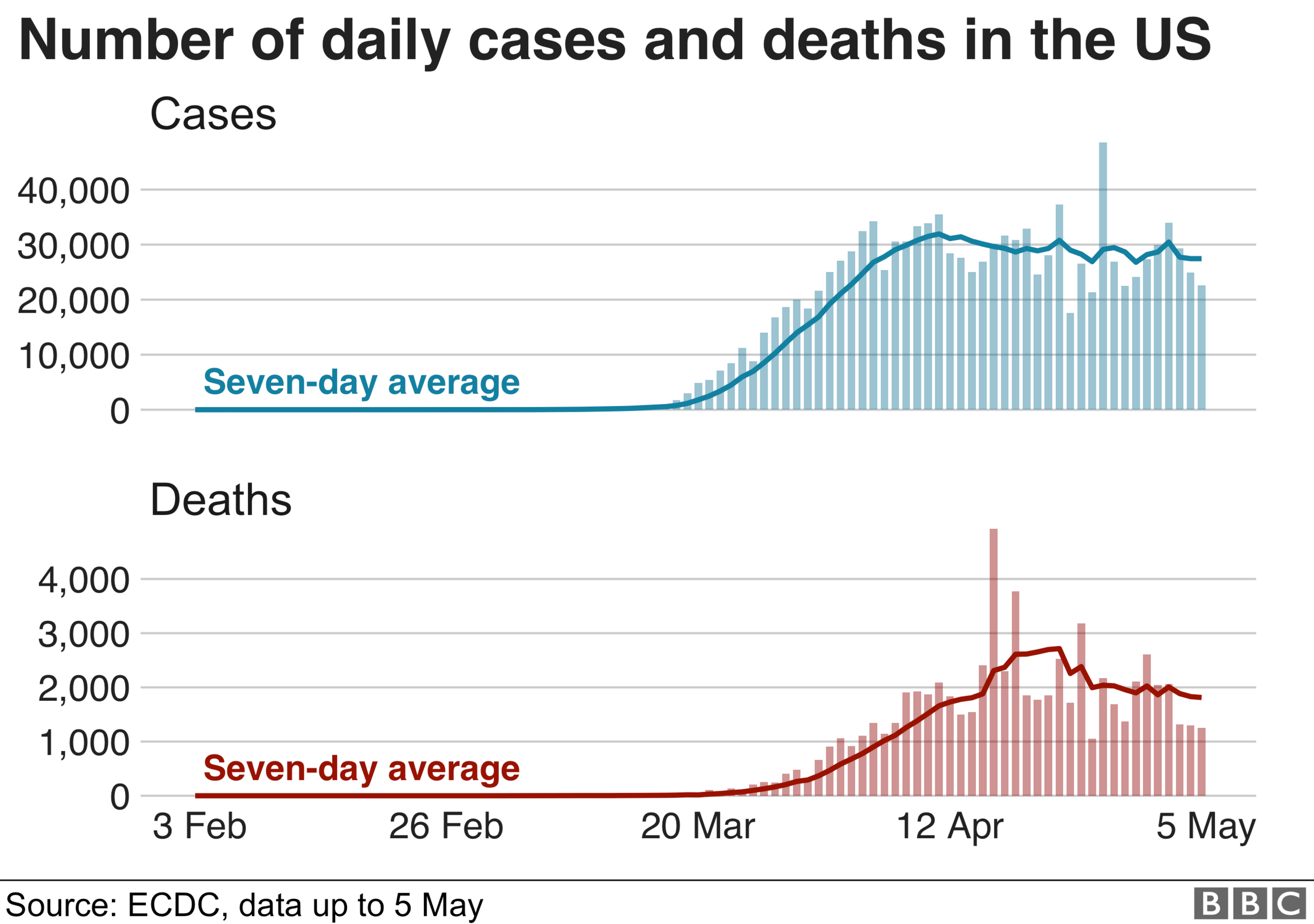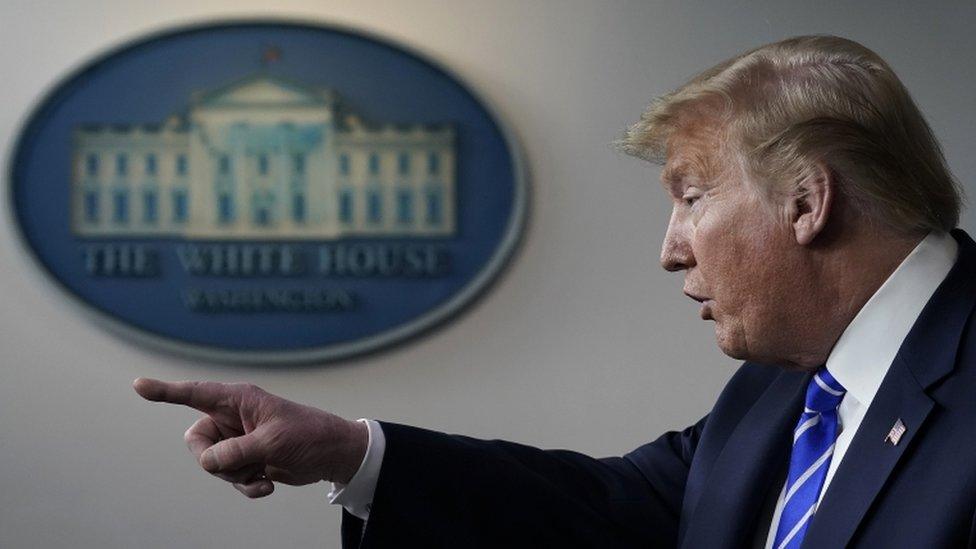Coronavirus: Trump says virus task force to focus on reopening economy
- Published

President Trump said the White House task force would focus on "opening up our country"
US President Donald Trump has said the coronavirus task force will shift its focus to reopening the economy, a day after suggesting it would be disbanded.
Mr Trump said the group would "continue on indefinitely" and "focus on safety [and] opening up our country".
It is not clear how exactly the task force will change but Mr Trump said "we may add or subtract people to it".
New confirmed infections per day in the US currently top 20,000, and daily deaths exceed 1,000.
US health officials have warned that the virus may spread as businesses begin to reopen.
The US currently has 1.2 million confirmed coronavirus infections and more than 71,000 related deaths, according to Johns Hopkins University which is tracking the pandemic.
What did President Trump say?
In a series of tweets on Wednesday, external, Mr Trump said the task force had "done a fantastic job of bringing together vast [and] highly complex resources".
He praised Vice-President Mike Pence, who heads the group, and said it had "set a high standard for others to follow".
"Because of this success, the Task Force will continue on indefinitely with its focus on safety & opening up our country again," Mr Trump said.
Trump: 'Mike Pence and the taskforce have done a great job'
His comments came a day after he suggested the task force, which is made up of medical professionals and other experts, might be disbanded.
"We're now looking at a little bit of a different form, and that form is safety and opening," Mr Trump told journalists on Tuesday. "And we'll have a different group probably set up for that."
Mr Pence also told reporters in a briefing on Tuesday that the task force could soon be wound down.
He said the Trump administration was "starting to look at the Memorial Day [late May] window, early June window as a time when we could begin to transition back to having our agencies begin to manage... our national response."
But - when asked about the apparent change in approach on Wednesday - Mr Trump said: "I had no idea how popular the task force is until... yesterday when I started talking about winding [it] down."

A shift in priorities for the task force

Is a task force with different people and a different focus still the same task force?
This sounds like a philosophical question but it is one that has very real implications for the direction of US coronavirus policy.
On Tuesday, Vice-President Mike Pence confirmed the White House was considering winding down its coronavirus task force, perhaps as early as the end of May, shifting public health responsibilities to subsidiary agencies.
Mr Trump walked that back a bit on Wednesday morning but the bottom line is the same. The group's members may change, and its priorities will shift.
However the president wants to dress it up, it's clear that even while the virus continues to spread throughout the nation, the White House urgently wants to prioritise addressing the economic fallout of the pandemic.
The state of the economy, after all, frequently determines the fate of a president seeking re-election. And if Trump can't pull the nation out of its fiscal nosedive soon, his November general election outlook appears grim.
The public health wisdom of the White House's move may be debatable, but the political calculus is clear.

The task force was set up on 29 January. It reports to the president and co-ordinates with medical institutes, political staff and state governors. The group also consults medical experts to formulate national guidelines on social distancing.
Its members include more than 20 experts and leading administration officials. The White House said the task force's duty was to "lead the administration's efforts to monitor, contain and mitigate the spread of the virus" and provide the public with information.
Mr Trump's once-daily task force briefings have become increasingly scarce since he was widely condemned by the medical community for pondering at the podium last month whether injecting bleach might kill the virus.
Dr Deborah Birx is the task force's response co-ordinator. The president was asked on Tuesday whether she and another high-profile member, Dr Anthony Fauci, would still be involved in efforts to address the coronavirus.
"They will be and so will other doctors and so will other experts in the field," the president said. He later added that new members of the task force would be announced by Monday.
Critics have accused Mr Trump of sacrificing Americans' public health in his eagerness to reopen the US economy ahead of his re-election battle in November.
In Arizona on Tuesday, Mr Trump said that Democrats were hoping his coronavirus policy would fail "so they can win the election".
However, it will be up to individual states to determine how they reopen.
Some Democratic governors in badly hit states have been cautious, calling for more testing and other safeguards before easing lockdowns. Other states, many led by Republicans in the south and mid-west, have already begun lifting restrictions.

Does the US have the pandemic under control?
Not yet. Besides New York, which is still the US epicentre despite an ongoing drop in new cases, the level of infection continues to climb across much of the country.
Many states that have allowed some business to resume - including Texas, Iowa, Minnesota, Tennessee, Kansas, Nebraska and Indiana - are seeing more new cases reported daily.
While some cities such as New York, New Orleans and Detroit have shown improvement, others like Los Angeles, Washington DC and Chicago are seeing the caseload rise every day.
Coronavirus: When might Hollywood reopen for business?
According to a report from the Federal Emergency Management Agency (Fema), more than 3,000 people may be killed by the virus each day by next month.
The White House has dismissed the report as inaccurate, with Mr Trump saying it describes a scenario in which Americans make no effort to mitigate the spread of the infection.
On Sunday, the president increased his forecast for the number of US pandemic deaths to 100,000, after saying two weeks earlier that it would be fewer than 60,000.
The Institute for Health Metrics and Evaluation at the University of Washington, a public forecast model that has been frequently cited by the White House, now estimates that Covid-19 will account for 135,000 American deaths by 4 August. This more than doubles its 17 April forecast.
Meanwhile, Secretary of State Mike Pompeo continued to criticise China over its handling of the outbreak.
"China could have prevented the deaths of hundreds of thousands of people worldwide," he told reporters on Wednesday. "China could have spared the world a descent into global economic malaise. They had a choice but instead [they] covered up the outbreak."
He did not provide evidence for his claim, which was the latest example of the US condemning Beijing's approach to the pandemic.
Mr Pompeo earlier said - without going into specifics - that there was "enormous evidence" the coronavirus emanated from a laboratory in the city of Wuhan. Chinese state media later accused him of lying.

A SIMPLE GUIDE: What are the symptoms?
LIKE 9/11 EACH DAY: A New York paramedic's diary
FACTORY HOTSPOT: The untold story behind America's biggest outbreak
GUNS & CHEESE: The unexpected items deemed 'essential'
HOW YOU CAN HELP: Write a diary, donate blood, read books to kids

- Published6 May 2020

- Published24 April 2020
